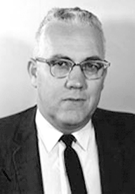Morris Hansen: Innovative, Influential, Inspiring
Megan Murphy, ASA Communications Manager
“When I started at the bureau, I was a youngster with much to learn.”
Morris Howard Hansen has been referred to as the 20th century’s most influential statistician when it comes to the evolution of survey methodology. He also influenced and inspired others. What’s interesting is that he didn’t start out wanting to be a statistician. It was while earning his undergraduate degree in accounting from the University of Wyoming that Hansen met Forrest Hall, the teacher who turned Hansen away from a career in accounting and toward a career in statistics. Hansen later called Hall an “exceedingly good teacher in statistics” and a great influence on his life.
Hansen Brought the First Computer to the Census
In 1945, Morris Hansen met with J. P. Eckert and J. W. Mauchly of Eckert-Mauchly Corporation to purchase the world’s first commercially available computer for the U.S. Census Bureau. The computer was called UNIVAC (UNIVersal Automatic Computer).
The first UNIVAC was delivered to the bureau on March 31, 1951, and dedicated on June 14 of that same year. Some facts about the UNIVAC:
The UNIVAC represented numbers in binary coded decimal with six bits for each digit
The central complex of the UNIVAC was about the size of a one-car garage: 14 feet by 8 feet by 8.5 feet high
It housed the mercury memory unit and all the central processing unit circuitry
It was a walk-in computer: a clear Plexiglas door provided access to the center of the system
Click here for more about the UNIVAC.
After earning his bachelor’s of science degree in 1934, Hansen worked as an accountant for a year before being offered the opportunity to work in the personnel division of the U.S. Census Bureau. A year later, he moved to the statistical division and, in 1940, earned his master’s degree in statistics from American University. “When I started at the bureau, I was a youngster with much to learn,” said Hansen. “A major goal of the Census Bureau at that time was to awaken and modernize. This created an excellent opportunity for innovation.”
Contributions
As chief of the Statistical Research Division at the U.S. Census Bureau, Hansen made several significant advancements to the census. One of his early contributions, in 1937, was the design of the Enumerative Check Census of Unemployment that sampled postal delivery routes and ratio estimators. He also helped convince the bureau to accept sampling and quality control methods in the 1940 Census and, in 1948, he convinced Phil Hauser, then acting director of the bureau, to let him conduct experiments in each census to test improvements for the next ones.
One of his more memorable concepts was total survey design. This meant the introduction of nonsampling error into alternative survey designs. The theory, known as the Census Bureau model of survey error, included the contribution of data collectors and data editors into the design of the survey.
Collaborations
Hansen gathered a talented team of statisticians while working at the Census Bureau, one of whom was Joseph Waksberg. In an interview with David Marker and David Morganstein, Waksberg said Hansen convinced the bureau to make two changes to the census: use sampling and take control of the interviewing process. Waksberg also noted it became clear to Hansen that “if you were concerned about the interviewer not using the correct words, then give the respondent the questionnaire to fill out.” This led to mailing the census questionnaire to respondents in advance during the 1960 Census.
Hansen believed in working with a team of people and in sharing credit for his accomplishments. “By and large, I think a team approach is what has made things work,” Hansen said in a 1983 interview with James O’Brien, former assistant division chief at the bureau. “Very rarely is there a conflict that you do not resolve by joint work before you try to confront people. … When there are things to fight for, fight for standards when they are needed, and do not fight for trivia.”
Hansen also collaborated for eight years with William Hurwitz and William Madow to produce the two-volume book Sample Survey Methods and Theory. The book was published in 1953 and became a standard reference for the theory and application of probability sampling.


















